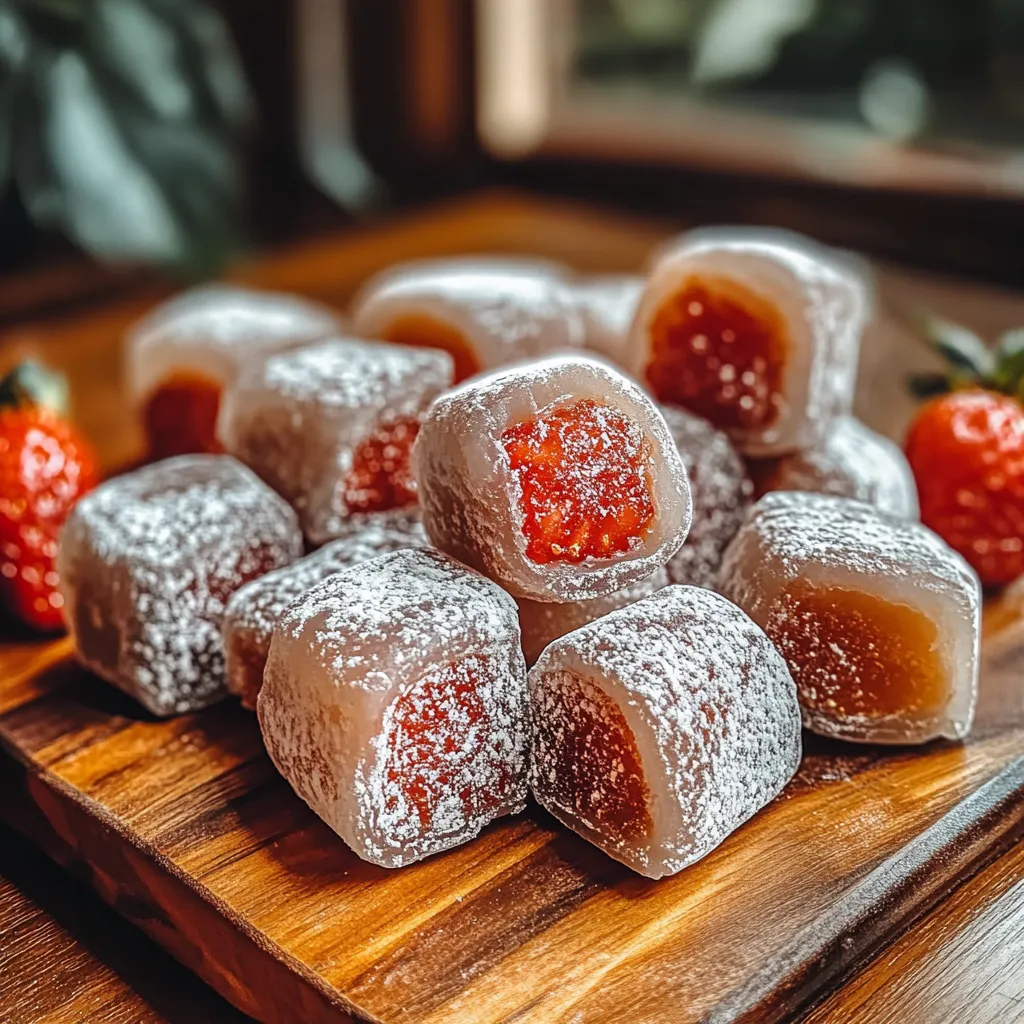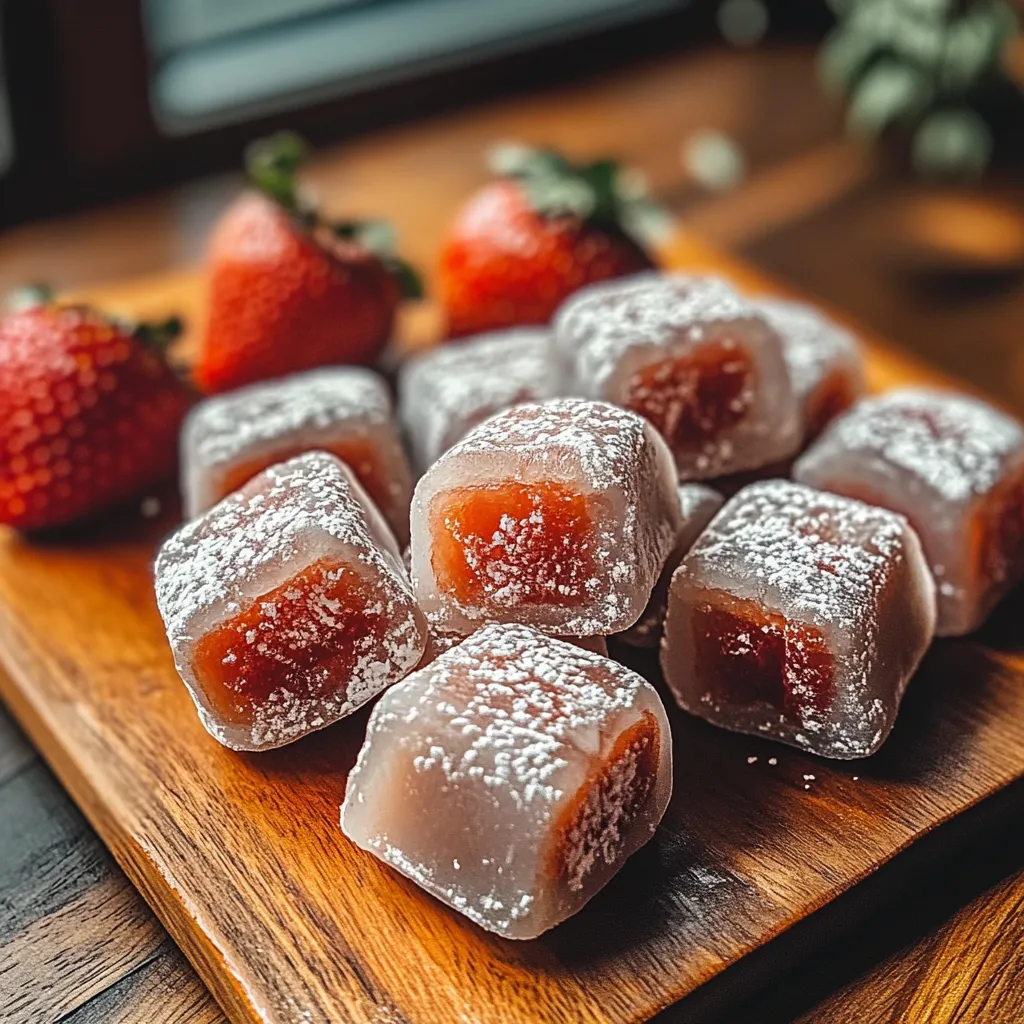 Pin it
Pin it
This strawberry mochi brings the delightful chewy texture of traditional Japanese mochi together with fresh, juicy strawberries for a perfect spring or summer treat. The combination creates a beautiful balance between the subtle sweetness of the rice flour wrapper and the bright, natural flavor of fresh berries.
I first made these strawberry mochi for a friend's cherry blossom viewing party, and they've become my signature dessert for gatherings. The pink hue from the strawberries always brings a smile to everyone's face.
Ingredients
- Sweet rice flour: Also called glutinous rice flour or mochiko, gives that signature stretchy, chewy texture that defines great mochi
- Granulated sugar: Provides just enough sweetness without overpowering the delicate flavors
- Water: Activates the starches in the rice flour to create that distinctive elastic texture
- Vanilla extract: Adds subtle depth to complement the strawberry flavor
- Cornstarch: Prevents sticking and creates that pleasantly powdery exterior
- Fresh strawberries: Bring natural sweetness and beautiful color; look for plump berries with vibrant red color
- Red bean paste (optional): Traditional Japanese sweet filling that pairs wonderfully with strawberries
Step-by-Step Instructions
- Prepare the Batter:
- Combine sweet rice flour and sugar in a mixing bowl until fully incorporated. The sugar should be evenly distributed throughout the flour. Add water and vanilla extract, stirring continuously until you achieve a completely smooth consistency with no lumps. The batter should be slightly thick but pourable, similar to pancake batter.
- Cook the Mochi:
- Pour your prepared batter into a microwave-safe dish lined with parchment paper to prevent sticking. Cover with plastic wrap, leaving a small opening for steam to escape. Microwave on high power for 2-3 minutes, watching carefully as it cooks. The mochi is ready when it becomes translucent and puffs up slightly. The texture will change from liquid to solid but remain very soft.
- Cool and Prepare Surface:
- Allow the cooked mochi to cool for about 5 minutes until it's safe to handle but still pliable. Meanwhile, generously dust your work surface with cornstarch. This is crucial as mochi is extremely sticky. Transfer the warm mochi onto the prepared surface and dust the top liberally with more cornstarch.
- Shape and Fill:
- Using a rolling pin, gently roll the mochi into an even sheet approximately 1/4 inch thick. Work carefully to maintain even thickness throughout. Cut the sheet into 3-inch squares using a sharp knife or cookie cutter. Place a strawberry slice and small spoonful of red bean paste, if using, in the center of each square. Fold the edges up and over the filling, pinching the seams together to seal completely.
 Pin it
Pin it
The first time I introduced my grandmother to strawberry mochi, she was skeptical about the combination. After one bite, she declared it even better than the traditional red bean version she grew up with in Japan. Now it's become our special grandmother-granddaughter baking tradition every spring when strawberries are at their peak.
Make Ahead and Storage
Freshly made mochi is at its perfect texture right after preparation, but you can store these treats for up to 2 days. Keep them in an airtight container at room temperature with a light dusting of cornstarch between layers to prevent sticking. Refrigeration will cause the mochi to harden, but you can bring them back to room temperature or microwave for 5-10 seconds to restore some of their softness. For longer storage, wrap each mochi individually in plastic wrap and freeze for up to one month. Thaw at room temperature for about 30 minutes before serving.
Flavor Variations
While fresh strawberries create a delightful filling, this versatile recipe welcomes many creative adaptations. For a more traditional Japanese approach, omit the strawberries and use sweetened red bean paste alone. To create colorful variations, add a few drops of food coloring to the mochi batter or incorporate matcha powder for a green tea version. Chocolate lovers can add a small piece of chocolate alongside the strawberry, which will melt slightly from the warmth of the freshly made mochi. You can also experiment with different extracts like almond or coconut instead of vanilla to complement various fillings.
Cultural Significance
Mochi holds deep cultural importance in Japanese tradition, particularly during New Year celebrations when special mochi called kagami mochi is offered at household altars. The stretchy texture symbolizes longevity and the strength of family bonds. While traditional mochi typically contains red bean paste, modern interpretations often incorporate seasonal fruits like strawberries. This adaptation maintains the cultural essence while creating a refreshing twist that appeals to contemporary palates. Sharing mochi is considered an act of goodwill and community connection in Japanese culture, making these strawberry-filled treats perfect for bringing people together.
 Pin it
Pin it
Strawberry mochi is a treat that brings together tradition and creativity in perfect harmony. Enjoy making and sharing this delightful dessert!
Frequently Asked Questions
- → Can I use other fruits instead of strawberries?
Yes! Mochi works beautifully with many fruits. Try mango, peach, blueberries, or kiwi slices. Just ensure the fruit is ripe but firm enough to hold its shape when wrapped in the mochi dough.
- → Why is my mochi too sticky to work with?
Stickiness is common with mochi. Make sure to use plenty of cornstarch when handling the dough. If it's still too sticky, you can refrigerate the dough for 10-15 minutes to make it easier to work with.
- → Can I make strawberry mochi ahead of time?
Fresh mochi is best consumed within 24 hours. You can prepare it a few hours ahead and store at room temperature. For longer storage, refrigerate for up to 2 days, but note that the texture will become firmer.
- → What is sweet rice flour and can I substitute it?
Sweet rice flour (also called glutinous rice flour or mochiko) is essential for achieving the chewy, elastic texture. Regular rice flour won't work as a substitute as it lacks the sticky properties needed for proper mochi.
- → Can strawberry mochi be frozen?
Yes, you can freeze unfilled mochi dough for up to a month. However, filled mochi doesn't freeze well as the strawberries will release water when thawed, making the mochi soggy. It's best to freeze the dough and add fresh fillings after thawing.
- → Is there a stovetop method instead of using a microwave?
Absolutely! You can steam the mochi mixture in a heat-proof bowl over simmering water for about 15-20 minutes, stirring occasionally until the mixture becomes translucent and sticky. This traditional method often results in a more even texture.
